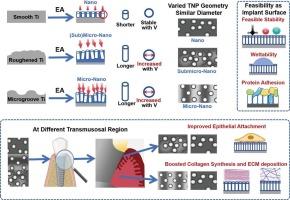Beyond diameters: Decoding fabrication patterns of hierarchical micro-nano titanium implants via anodization and their geometries on region-specific soft-tissue integration
IF 7.9
2区 材料科学
Q1 MATERIALS SCIENCE, MULTIDISCIPLINARY
引用次数: 0
Abstract
Electrochemical anodization creates titania nanopores (TNPs) on Ti implants with distinctive micro-nano geometries to enhance their surface bioactivity, showing the potential to improve soft-tissue integration at varied transmucosal regions. However, understanding how topography regulates TNP dimensions under voltage, and the clinical feasibility of diverse TNP geometries was limited. More crucially, existing research predominantly focused on nanopore diameter, neglecting other geometric characteristics (alignment, texture/roughness) on soft-tissue cells that impeded optimized TNPs design for ideal soft-tissue integration. This study showed nanopore dimensions were voltage-dependent on micro-patterned Ti but remain stable on smooth counterparts. Varied TNPs with similar diameters but different alignment/roughness were selected and identified with similar chemistry/hydrophilicity, but their protein adhesion and stability were length-dependent, showing their feasibility as implant devices. Finally, human gingival fibroblasts (HGFs) and HaCaT epithelial cells functions on varied selected TNPs reflected that nanopores inherently promoted cell responses, but hybrid microgroove-nanopores dramatically enhanced HGF’s collagen and fibronectin secretion, while irregular textured nanopores significantly improved HaCaT adhesion. By addressing the gaps in understanding topographical regulation and the influence of overlooked geometric features beyond diameter, this work advances spatially optimized implant designs for improved epithelial sealing and connective tissue integration at different transmucosal zones for improved implant health.

超越直径:通过阳极氧化解码分层微纳米钛植入物的制造模式及其对特定区域软组织整合的几何形状
电化学阳极氧化在钛植入物上产生具有独特微纳几何形状的二氧化钛纳米孔(TNPs),以增强其表面生物活性,显示出改善不同粘膜区域软组织整合的潜力。然而,了解地形如何在电压下调节TNP尺寸,以及不同TNP几何形状的临床可行性是有限的。更重要的是,现有的研究主要集中在纳米孔直径上,而忽略了软组织细胞的其他几何特征(排列、纹理/粗糙度),这些特征阻碍了优化TNPs设计,以实现理想的软组织整合。这项研究表明,纳米孔的尺寸是电压依赖于微图案钛,但保持稳定的光滑对应物。选择不同的TNPs,直径相似,但排列/粗糙度不同,并鉴定出相似的化学/亲水性,但它们的蛋白质粘附性和稳定性与长度有关,表明它们作为植入装置的可行性。最后,人类牙龈成纤维细胞(HGF)和HaCaT上皮细胞在不同选择的TNPs上的功能反映了纳米孔内在地促进了细胞反应,但混合微沟-纳米孔显著增强了HGF的胶原和纤维连接蛋白分泌,而不规则纹理纳米孔显著改善了HaCaT的粘附。通过解决在理解地形调节和被忽视的直径以外的几何特征的影响方面的差距,本研究推进了空间优化的种植体设计,以改善不同粘膜带的上皮密封和结缔组织整合,从而改善种植体健康。
本文章由计算机程序翻译,如有差异,请以英文原文为准。
求助全文
约1分钟内获得全文
求助全文
来源期刊

Materials & Design
Engineering-Mechanical Engineering
CiteScore
14.30
自引率
7.10%
发文量
1028
审稿时长
85 days
期刊介绍:
Materials and Design is a multi-disciplinary journal that publishes original research reports, review articles, and express communications. The journal focuses on studying the structure and properties of inorganic and organic materials, advancements in synthesis, processing, characterization, and testing, the design of materials and engineering systems, and their applications in technology. It aims to bring together various aspects of materials science, engineering, physics, and chemistry.
The journal explores themes ranging from materials to design and aims to reveal the connections between natural and artificial materials, as well as experiment and modeling. Manuscripts submitted to Materials and Design should contain elements of discovery and surprise, as they often contribute new insights into the architecture and function of matter.
 求助内容:
求助内容: 应助结果提醒方式:
应助结果提醒方式:


